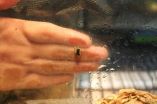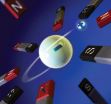(Press-News.org) Scientists are reporting the first direct evidence that a subtle change in the physical properties of a tissue can affect its function. The finding has immediate implications for understanding several rare hearing disorders, they said, and ultimately could offer insight into such conditions as osteoporosis, arthritis, cardiovascular disease and cancer.
In their study, the scientists discovered that blocking the function of a particular molecule in the ear bone of mice decreased the hardness of the bone, causing hearing loss. Reactivating the molecule restored the bone's hardness – and the animals' hearing.
The research likely explains the previously unknown cause of hearing loss in the human disease cleidocranial dysplasia, a genetic bone syndrome, said co-author Lawrence Lustig, MD, UCSF professor of otolaryngology, and may explain hearing loss associated with some other bone diseases.
More broadly, the finding reveals the molecular pathway that regulates the physical properties of extracellular matrix – the interlocking mesh of molecules between cells – in the ear's cochlear bone. The matrix is responsible for the hardness of human tissues, ranging from stiff bone and enamel to compliant brain and skin.
Perhaps most intriguing is the discovery that variations in the physical properties of extracellular matrix affect tissue function. This finding should lead to insights into abnormal matrix properties in the tissues of diseases throughout the body, the researchers said, including osteoporosis and arthritis.
"Our finding demonstrates that establishing and maintaining the proper calibration of physical properties is essential for healthy tissue function," said the senior author of the study, Tamara Alliston, PhD, assistant professor of orthopaedic surgery and a member of the Eli and Edythe Broad Center of Regeneration Medicine and Stem Cell Research at UCSF.
Scientists have known that physical cues, such as extracellular matrix stiffness, direct the differentiation of stem cells into specific cell types, such as heart, liver and brain cells. They also have known that disruption of these cues underlies a wide range of diseases, such as osteoarthritis, cardiovascular disease and cancer.
However, they have not known the molecular mechanisms that establish the physical properties of extracellular matrix, nor the link between these properties and tissue function.
In the current study, recently reported in EMBO (online Sept. 17, 2010), the team, led by Jolie L. Chang, MD, a resident in the UCSF Department of Otolaryngology and Head and Neck Surgery, set out to investigate the mechanisms involved.
Earlier studies, conducted at UCSF, showed that a molecule known as transforming growth factor beta (TGF-β) regulates the turnover of bone cells known as osteoblasts, by inhibiting a molecule known as Runx2. Disrupting TGF-β's regulation of Runx2 causes dysplastic clavicles and open cranial sutures.
These skeletal deformities, seen in the human genetic bone disease cleidocranial dysplasia, result from a defective copy of the Runx2 gene. Patients with CCD experience "sensorineural" hearing loss – caused by damage to the cochlear bone or nerve damage.
Given these conditions, the teams used two mouse models of CCD to study the regulation and role of bone matrix properties in the cochlear bone.
They focused on this bone in part because of anecdotal evidence in patients, and research in whales, flamingos and polar bears, indicating that the bone is the hardest in the body, possibly helping the animals hear under water. The required stiffness, the team suspected, likely would be precisely calibrated.
They first conducted a nanoscale analysis of several mouse bones in the head and ear, establishing that the cochlea bone was by far the stiffest.
Then, in what they considered a major insight, they discovered that TGF-β regulates Runx2 to establish the physical property of the extracellular matrix of the cochlea bone. "This told us," said Chang, "that Runx2 -- a key transcriptional regulator that helps the cell selects its cell fate -- also controls the physical properties of the matrix."
Finally, by manipulating Runx2 activity through TGF-β, the team determined that the physical quality of the bone matrix affects hearing.
Now, the team is investigating the molecules "downstream" of Runx2, to gain further insight into the mechanism regulating the physical properties of bone. They also are studying if these mechanisms define the stiffness of matrices in other skeletal tissues.
"We want to see if TGF-β targets the cartilage transcription factor to make cartilage more or less stiff," Alliston said. "We think that the stiffness is degraded in arthritis and that this further disrupts chondrocyte cells, exacerbating the disease."
INFORMATION:
Other co-authors of the study are Delia S. Brauer, Jacob Johns, Carol Chen, Omar Akil, Emily N. Chin, Kristen Butcher, Richard A. Schneider, Anil Lalwani, Rik Derynck, Grayson W. Marshall, and Sally J. Marshall, of UCSF, Guive Balooch, at the time a postdoctoral fellow in the lab of co-author Robert O. Ritchie, of UC Lawrence Berkeley National Laboratories, Mary Beth Humphrey, of University of Oklahoma Health Science Center, and Alexandra E Porter, of Imperial College London.
The study was funded primarily by the National Institutes of Health, the Deafness Research Foundation, The Arthritis Foundation, UCSF School of Dentistry Creativity Fund, Arthritis Foundation, Deafness Research Foundation and Department of Energy.
UCSF is a leading university dedicated to promoting health worldwide through advanced biomedical research, graduate-level education in the life sciences and health professions, and excellence in patient care.
Follow UCSF on Twitter at http://twitter.com/ucsf
Related links:
EMBO Reports:
Published online: 17 September 2010
http://www.nature.com/embor/journal/v11/n10/full/embor2010135.html
Eli and Edythe Broad Center of Regeneration Medicine and Stem Cell Research at UCSF
http://stemcell.ucsf.edu/
UCSF Department of Orthopaedic Surgery
http://orthosurg.ucsf.edu/
Hearing loss study reveals role of bone hardness in tissue function
2010-11-18
ELSE PRESS RELEASES FROM THIS DATE:
National Zoo and partners first to breed critically endangered tree frog
2010-11-18
As frogs around the world continue to disappear—many killed by a rapidly spreading disease called chytridiomycosis, which attacks the skin cells of amphibians—one critically endangered species has received an encouraging boost. Although the La Loma tree frog, Hyloscirtus colymba, is notoriously difficult to care for in captivity, the Panama Amphibian Rescue and Conservation Project is the first to successfully breed this species.
"We are some of the first researchers to attempt to breed these animals into captivity and we have very little information about how to care ...
Antimatter atoms stored for the first time
2010-11-18
Atoms of antimatter have been trapped and stored for the first time by the ALPHA collaboration, an international team of scientists working at CERN, the European Organization for Nuclear Research near Geneva, Switzerland. Scientists from the U.S. Department of Energy's Lawrence Berkeley National Laboratory and the University of California at Berkeley have made key contributions to the ongoing international effort.
ALPHA stored atoms of antihydrogen, consisting of a single negatively charged antiproton orbited by a single positively charged anti-electron (positron). While ...
Antimatter atoms produced and trapped at CERN
2010-11-18
Geneva, 17 November 2011. The ALPHA experiment at CERN has taken an important step forward in developing techniques to understand one of the Universe's open questions: is there a difference between matter and antimatter? In a paper published in Nature today, the collaboration shows that it has successfully produced and trapped atoms of antihydrogen. This development opens the path to new ways of making detailed measurements of antihydrogen, which will in turn allow scientists to compare matter and antimatter.
Antimatter – or the lack of it – remains one of the biggest ...
Pelletized manure reduces toxic runoff
2010-11-18
Madison WI November 17 2010 – There is considerable amount of uncertainty concerning the environmental impacts that animal hormones have on surface water. Higher concentrations of hormones in waterways have been found to cause physiological and sexual impairment in fish and other aquatic species. However, a study from the University of Delaware that examined estrogen concentrations runoff from agricultural fields fertilized with chicken manure found that it is as much about the application of the manure as it is about the measurement of the types of estrogen.
The study ...
College job market to see slight rebound
2010-11-18
EAST LANSING, Mich. — The national job market for college graduates should rebound slightly next year as many large corporations end hiring freezes and small, fast-growth companies continue helping reshape the economy, according to Michigan State University's 2010-11 Recruiting Trends report.
Overall hiring is expected to increase 3 percent, with bachelor's-level and MBA-level hiring both surging 10 percent, said Phil Gardner, director of MSU's Collegiate Employment Research Institute, which conducted the survey of some 4,600 employers.
Geographically, the Great Lakes ...
Nanoscale probe reveals interactions between surfaces and single molecules
2010-11-18
As electronics become smaller and smaller the need to understand nanoscale phenomena becomes greater and greater. Because materials exhibit different properties at the nanoscale than they do at larger scales, new techniques are required to understand and to exploit these new phenomena. A team of researchers led by Paul Weiss, UCLA's Fred Kavli Chair in NanoSystems Sciences, has developed a tool to study nanoscale interactions. Their device is a dual scanning tunneling and microwave-frequency probe that is capable of measuring the interactions between single molecules and ...
Coaching with compassion can 'light up' human thoughts
2010-11-18
CLEVELAND – Coaching happens just about everywhere, and every day, with learning as the goal.
Effective coaching can lead to smoothly functioning organizations, better productivity and potentially more profit. In classrooms, better student performance can occur. Doctors or nurses can connect more with patients. So, doing coaching right would seem to be a natural goal, and it has been a major topic of research at Case Western Reserve University's Weatherhead School of Management since 1990.
For all the energy and money spent on coaching, there is little understanding ...
New insight into the cause of common dementia found by researchers at Mayo Clinic
2010-11-18
JACKSONVILLE, Fla. — Researchers at the Mayo Clinic campus in Florida have found a clue as to how some people develop a form of dementia that affects the brain areas associated with personality, behavior, and language.
In the Nov. 17 online issue of the American Journal of Human Genetics, the scientists write that they discovered a link between two proteins — progranulin and sortilin — they say might open new avenues for the treatment of frontotemporal lobar degeneration (FTLD), which occurs in the frontal lobe and temporal lobe of the brain. This form of dementia, which ...
Vitamin C: A potential life-saving treatment for sepsis
2010-11-18
Physicians caring for patients with sepsis may soon have a new safe and cost-effective treatment for this life-threatening illness. Research led by Dr. Karel Tyml and his colleagues at The University of Western Ontario and Lawson Health Research Institute have found that vitamin C can not only prevent the onset of sepsis, but can reverse the disease.
Sepsis is caused by a bacterial infection that can begin anywhere in your body. Your immune system goes into overdrive, overwhelming normal processes in your blood. The result is that small blood clots form, blocking blood ...
Queen's University scientists discover new method for studying molecules
2010-11-18
KINGSTON, ON – Researchers at Queen's University have discovered the method for studying oxygen in large molecular systems. The findings will help in the study of proteins, DNA, RNA and other molecular structures.
Biological molecules make up all living creatures on earth and contain four major elements – hydrogen, carbon, nitrogen and oxygen. But until now scientists were only able to use nuclear magnetic resonance (NMR) to study three out of the four elements in the molecule puzzle because oxygen wavelengths were difficult to detect.
"Oxygen signals were so weak, ...


